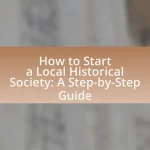Funding opportunities for local historical research initiatives are essential for preserving and interpreting regional history. This article outlines various funding sources, including government grants, private foundations, and community crowdfunding platforms, highlighting their importance in enabling thorough research and community engagement. It discusses the criteria funding organizations consider, the impact of financial support on project success, and strategies for local organizations to effectively apply for and manage grants. Additionally, the article emphasizes the role of collaboration and community involvement in enhancing funding opportunities and ensuring the sustainability of historical research projects.
What are Funding Opportunities for Local Historical Research Initiatives?
Funding opportunities for local historical research initiatives include grants from government agencies, private foundations, and nonprofit organizations. For example, the National Endowment for the Humanities offers grants specifically for projects that preserve and interpret local history. Additionally, state historical societies often provide funding for local initiatives aimed at documenting and researching regional history. Local community foundations may also support historical research projects that benefit the community. These funding sources are essential for enabling researchers to explore and document local historical narratives, ensuring that valuable cultural heritage is preserved and accessible.
Why are funding opportunities important for local historical research?
Funding opportunities are crucial for local historical research because they provide the necessary financial resources to conduct thorough investigations and preserve historical artifacts. Without funding, researchers may lack access to essential materials, technology, and manpower needed to explore and document local history effectively. For instance, a study by the National Endowment for the Humanities highlights that grants enable projects that uncover and interpret local narratives, fostering community engagement and education. Additionally, funding supports the digitization of historical records, making them accessible to a broader audience, which is vital for preserving local heritage.
What impact does funding have on the success of historical research initiatives?
Funding significantly enhances the success of historical research initiatives by providing essential resources for research activities. Adequate funding allows researchers to access archival materials, conduct fieldwork, and employ skilled personnel, which are critical for producing high-quality historical analyses. For instance, a study by the National Endowment for the Humanities found that projects with robust financial backing were more likely to complete their research on time and disseminate their findings effectively. Furthermore, funding can facilitate collaboration among historians, institutions, and communities, leading to more comprehensive and impactful research outcomes.
How does funding influence community engagement in historical research?
Funding significantly enhances community engagement in historical research by providing necessary resources for outreach, collaboration, and participation. When financial support is available, historical research initiatives can organize events, workshops, and educational programs that actively involve community members. For instance, grants from organizations like the National Endowment for the Humanities enable local historical societies to create public history projects that invite community input and participation, fostering a sense of ownership and connection to local history. Additionally, funding allows for the development of digital platforms that facilitate broader access to historical materials, encouraging community members to engage with their heritage in meaningful ways.
What types of funding sources are available for local historical research?
Various funding sources are available for local historical research, including government grants, private foundations, and crowdfunding platforms. Government grants, such as those from the National Endowment for the Humanities, provide financial support for projects that preserve and interpret local history. Private foundations, like the Getty Foundation, often offer grants specifically for historical research and preservation initiatives. Additionally, crowdfunding platforms, such as Kickstarter or GoFundMe, allow researchers to raise funds directly from the community, engaging local stakeholders in the process. These funding sources collectively enhance the capacity for local historical research by providing necessary financial resources.
What are the differences between public and private funding sources?
Public funding sources are government-based financial resources, while private funding sources are provided by individuals, foundations, or corporations. Public funding typically comes from taxpayer money and is often allocated through grants, subsidies, or appropriations for specific projects that serve the public interest, such as historical preservation initiatives. In contrast, private funding is usually driven by the interests and priorities of the donors, which may include philanthropic goals or corporate social responsibility, and can be more flexible in terms of project scope and application processes. Public funding often requires adherence to strict regulations and accountability measures, whereas private funding may have fewer restrictions but can be more competitive and dependent on the donor’s vision.
How can local organizations access grants for historical research?
Local organizations can access grants for historical research by identifying relevant funding sources such as government agencies, private foundations, and nonprofit organizations that specifically support historical projects. For instance, the National Archives and Records Administration offers grants through its National Historical Publications and Records Commission, which funds projects that preserve and provide access to historical records. Additionally, local organizations can explore state and regional historical societies that often have grant programs tailored to community-based historical research initiatives. These funding opportunities typically require a detailed proposal outlining the project’s significance, methodology, and budget, ensuring that the organization meets the specific criteria set by the funding body.
What criteria do funding organizations typically consider?
Funding organizations typically consider the project’s alignment with their mission and goals, the potential impact of the research, the qualifications of the research team, and the feasibility of the proposed budget and timeline. These criteria ensure that the funding is directed towards initiatives that are not only relevant but also capable of producing meaningful results. For instance, organizations often prioritize projects that address specific community needs or contribute to broader historical knowledge, as evidenced by the National Endowment for the Humanities, which emphasizes projects that enhance public understanding of history and culture.
How do project goals align with funding organization priorities?
Project goals align with funding organization priorities by ensuring that the objectives of the initiative directly address the mission and strategic interests of the funding body. For instance, if a funding organization prioritizes the preservation of local history, a project focused on documenting and archiving historical artifacts in a community will resonate with their goals. This alignment is often assessed through criteria such as relevance to community needs, potential for impact, and sustainability of outcomes, which are typically outlined in the funding organization’s guidelines. By demonstrating how the project contributes to these priorities, applicants can enhance their chances of securing funding.
What role does community involvement play in funding decisions?
Community involvement significantly influences funding decisions by demonstrating local support and engagement for projects. Funders often prioritize initiatives that reflect community needs and interests, as this increases the likelihood of project success and sustainability. For instance, studies show that projects with strong community backing are more likely to receive grants, as they indicate a higher potential for impact and relevance. Additionally, community involvement can enhance the credibility of proposals, making them more attractive to funding organizations that seek to invest in initiatives with a proven local commitment.
How can local historical research initiatives effectively apply for funding?
Local historical research initiatives can effectively apply for funding by clearly defining their project goals, demonstrating community impact, and aligning their objectives with the priorities of potential funders. Initiatives should prepare a comprehensive proposal that includes a detailed budget, a timeline, and evidence of community support, such as letters of endorsement from local organizations or stakeholders. Additionally, showcasing previous successful projects or partnerships can strengthen their application. According to the National Endowment for the Humanities, successful grant applications often highlight the significance of the research in preserving local history and engaging the community, which can increase the likelihood of securing funding.
What are the key components of a successful funding proposal?
The key components of a successful funding proposal include a clear project description, defined objectives, a detailed budget, a timeline, and an evaluation plan. A clear project description outlines the purpose and significance of the research, while defined objectives specify measurable outcomes. A detailed budget provides a breakdown of costs, ensuring transparency and feasibility. A timeline outlines the project phases and deadlines, facilitating project management. Lastly, an evaluation plan describes how the project’s success will be measured, ensuring accountability and effectiveness. These components collectively enhance the proposal’s clarity and persuasiveness, increasing the likelihood of securing funding.
How can organizations demonstrate the significance of their research?
Organizations can demonstrate the significance of their research by showcasing its impact on local communities and historical understanding. This can be achieved through case studies that illustrate how the research has informed policy decisions, contributed to community development, or preserved local heritage. For instance, a study by the National Endowment for the Humanities found that funded historical research projects increased public engagement and awareness of local history by 40%. By presenting such data and real-world applications, organizations can effectively communicate the value and relevance of their research to stakeholders and funding bodies.
What challenges do local historical research initiatives face in securing funding?
Local historical research initiatives face significant challenges in securing funding primarily due to limited financial resources and competition for grants. Many local initiatives operate on tight budgets and often lack the visibility that larger organizations have, making it difficult to attract donors or grant providers. Additionally, the increasing number of applicants for available funding creates a highly competitive environment, where only a small percentage of proposals receive financial support. According to a report by the National Endowment for the Humanities, local projects often struggle to demonstrate long-term impact or sustainability, which are critical factors for funders when making decisions.
How can organizations overcome common obstacles in the funding process?
Organizations can overcome common obstacles in the funding process by developing a clear and compelling funding proposal that addresses the specific needs and interests of potential funders. A well-structured proposal includes detailed project descriptions, clear objectives, and measurable outcomes, which enhance the likelihood of securing funding. Research indicates that organizations that tailor their proposals to align with funders’ priorities and demonstrate community impact are more successful; for instance, a study by the National Council of Nonprofits found that 70% of successful grant applications included specific data on community benefits. Additionally, building relationships with funders through networking and communication can facilitate trust and increase funding opportunities.
What strategies can be employed to enhance funding applications?
To enhance funding applications, applicants should focus on clearly articulating their project’s objectives, demonstrating community impact, and providing a detailed budget. Clearly defined objectives help reviewers understand the project’s purpose and goals, while showcasing community impact illustrates the significance of the research to local stakeholders. A detailed budget ensures transparency and shows that the applicant has thoughtfully planned the project’s financial aspects. Research indicates that applications with specific, measurable outcomes and a well-structured budget are more likely to receive funding, as they align with funders’ priorities for accountability and effectiveness.
What best practices should be followed when managing funded historical research projects?
Best practices for managing funded historical research projects include establishing clear objectives, maintaining transparent communication with stakeholders, and adhering to budgetary constraints. Clear objectives guide the research direction and ensure alignment with funding requirements. Transparent communication fosters collaboration and keeps all parties informed about progress and challenges. Adhering to budgetary constraints is crucial for financial accountability and project sustainability. Additionally, regular progress evaluations and documentation of findings enhance the project’s credibility and facilitate future funding opportunities. These practices are supported by the National Endowment for the Humanities, which emphasizes the importance of structured project management in successful grant-funded initiatives.
How can organizations ensure accountability and transparency in funding use?
Organizations can ensure accountability and transparency in funding use by implementing rigorous financial reporting and auditing processes. These processes involve regular audits by independent third parties, which help verify that funds are used as intended and in accordance with established guidelines. Additionally, organizations can adopt clear policies for fund allocation and reporting, ensuring that all stakeholders have access to detailed financial information. For instance, the International Federation of Accountants emphasizes the importance of transparency in financial reporting to build trust and accountability in organizations. By maintaining open communication with stakeholders and providing accessible financial records, organizations can foster a culture of accountability and transparency in their funding practices.
What methods can be used to evaluate the impact of funded initiatives?
To evaluate the impact of funded initiatives, methods such as quantitative analysis, qualitative assessments, and mixed-method approaches can be employed. Quantitative analysis involves measuring specific metrics, such as participant numbers or financial returns, to assess the initiative’s effectiveness. Qualitative assessments, including interviews and focus groups, provide insights into participant experiences and perceptions, revealing the initiative’s broader social impact. Mixed-method approaches combine both quantitative and qualitative data, offering a comprehensive view of the initiative’s outcomes. These methods are supported by research indicating that a combination of data types enhances the reliability of impact evaluations, as seen in studies conducted by the World Bank and other organizations focused on program effectiveness.
What resources are available for organizations seeking funding for historical research?
Organizations seeking funding for historical research can access various resources, including government grants, private foundations, and academic institutions. The National Endowment for the Humanities (NEH) offers grants specifically for historical research projects, while the American Historical Association provides a list of funding opportunities. Additionally, local historical societies often have grant programs to support regional research initiatives. These resources are validated by the existence of structured funding programs aimed at promoting historical scholarship and preserving cultural heritage.
How can local historical societies connect with funding networks?
Local historical societies can connect with funding networks by actively engaging with grant-making organizations and participating in community partnerships. These societies should research and identify potential funding sources such as government grants, private foundations, and corporate sponsorships that specifically support historical preservation and research initiatives. For instance, the National Endowment for the Humanities offers grants that local historical societies can apply for, which can provide substantial financial support for projects. Additionally, networking at local and national conferences can facilitate connections with funders and other organizations that share similar goals, enhancing their visibility and access to funding opportunities.
What online platforms provide information on funding opportunities?
Online platforms that provide information on funding opportunities include GrantWatch, Foundation Center, and Grants.gov. GrantWatch offers a comprehensive database of grants available across various sectors, including historical research. Foundation Center provides access to a wealth of resources on foundations and their funding priorities, making it easier for researchers to identify potential funding sources. Grants.gov is a government portal that lists federal funding opportunities, allowing users to search for grants relevant to local historical research initiatives. These platforms are widely recognized for their extensive databases and user-friendly interfaces, facilitating access to funding information for researchers.
How can collaboration enhance funding opportunities for local historical research?
Collaboration can enhance funding opportunities for local historical research by pooling resources, expertise, and networks among various stakeholders. When institutions such as universities, museums, and community organizations work together, they can present a more compelling case for funding by demonstrating a broader impact and shared commitment to preserving local history. For example, collaborative projects often attract grants from foundations that prioritize community engagement and interdisciplinary approaches, as seen in initiatives funded by the National Endowment for the Humanities, which supports collaborative research that involves multiple partners. This collective approach not only increases the visibility of the research but also diversifies the funding sources, making it more likely to secure financial support.
What are the benefits of partnering with other organizations for funding?
Partnering with other organizations for funding enhances resource access, increases credibility, and fosters collaboration. By joining forces, organizations can pool financial resources, share expertise, and leverage each other’s networks, which can lead to larger funding opportunities. For instance, collaborative projects often attract funders who prefer to support initiatives with multiple stakeholders, as this indicates a broader impact and shared commitment. Additionally, partnerships can lead to innovative approaches and solutions, making projects more appealing to potential funders.
How can collaborative projects attract more funding sources?
Collaborative projects can attract more funding sources by demonstrating a unified approach that combines resources, expertise, and community engagement. This collaborative framework enhances the project’s credibility and appeal to funders who prioritize partnerships and shared goals. For instance, studies show that projects with multiple stakeholders, such as local governments, educational institutions, and community organizations, are more likely to secure funding, as they present a broader impact and sustainability potential. Additionally, collaborative projects often leverage diverse funding streams, including grants, donations, and sponsorships, which can significantly increase financial support.
What tips can help local historical research initiatives succeed in securing funding?
Local historical research initiatives can succeed in securing funding by clearly defining their objectives and demonstrating community impact. Establishing a well-structured proposal that outlines specific goals, methodologies, and expected outcomes increases the likelihood of attracting funders. Engaging local stakeholders, such as community organizations and schools, can also enhance credibility and support. Additionally, showcasing previous successful projects or partnerships can provide evidence of capability and reliability, which funders often seek. According to the National Endowment for the Humanities, initiatives that align with community interests and demonstrate potential for educational outreach are more likely to receive funding.















